heating TOYOTA MATRIX 2009 E140 / 2.G Owners Manual
[x] Cancel search | Manufacturer: TOYOTA, Model Year: 2009, Model line: MATRIX, Model: TOYOTA MATRIX 2009 E140 / 2.GPages: 440, PDF Size: 9.39 MB
Page 103 of 440

103 2-1. Driving procedures
2
When driving
CAUTION
■When taking a nap in the vehicle
Always turn the engine off. Otherwise, you may accidentally move the shift
lever or depress the accelerator pedal, which could cause an accident or fire
due to engine overheating. Additionally, if the vehicle is parked in a poorly
ventilated area, exhaust gases may collect and enter the vehicle, leading to
death or a serious health hazard.
■When braking the vehicle
●When the brakes are wet, drive more cautiously. Braking distance
increases when the brakes are wet, and may cause one side of the vehicle
to brake differently than the other side. Also the parking brake may not
securely hold the vehicle.
●If the power brake assist function does not operate, do not follow other
vehicles closely and avoid downhills or sharp turns that require braking.
In this case, braking is still possible, but it will require more force on the
pedal than usual. Braking distance may also increase.
●Do not pump the brake pedal if the engine stalls.
Each push on the brake pedal uses up the reserve for the power-assisted
brakes.
●The brake system consists of 2 individual hydraulic systems: If one of the
systems fails, the other will still operate. In this case, the brake pedal
should be depressed more firmly than usual and braking distance
becomes longer.
Do not drive your vehicle with only a single brake system. Have your
brakes fixed immediately.
■If the vehicle becomes stuck or bogged (AWD models)
Do not spin the wheels recklessly when any of the tires is up in the air, or
stuck in sand or mud, etc. This may damage the drive system components
or propel the vehicle forward (or in another direction) and cause an accident.
Page 118 of 440
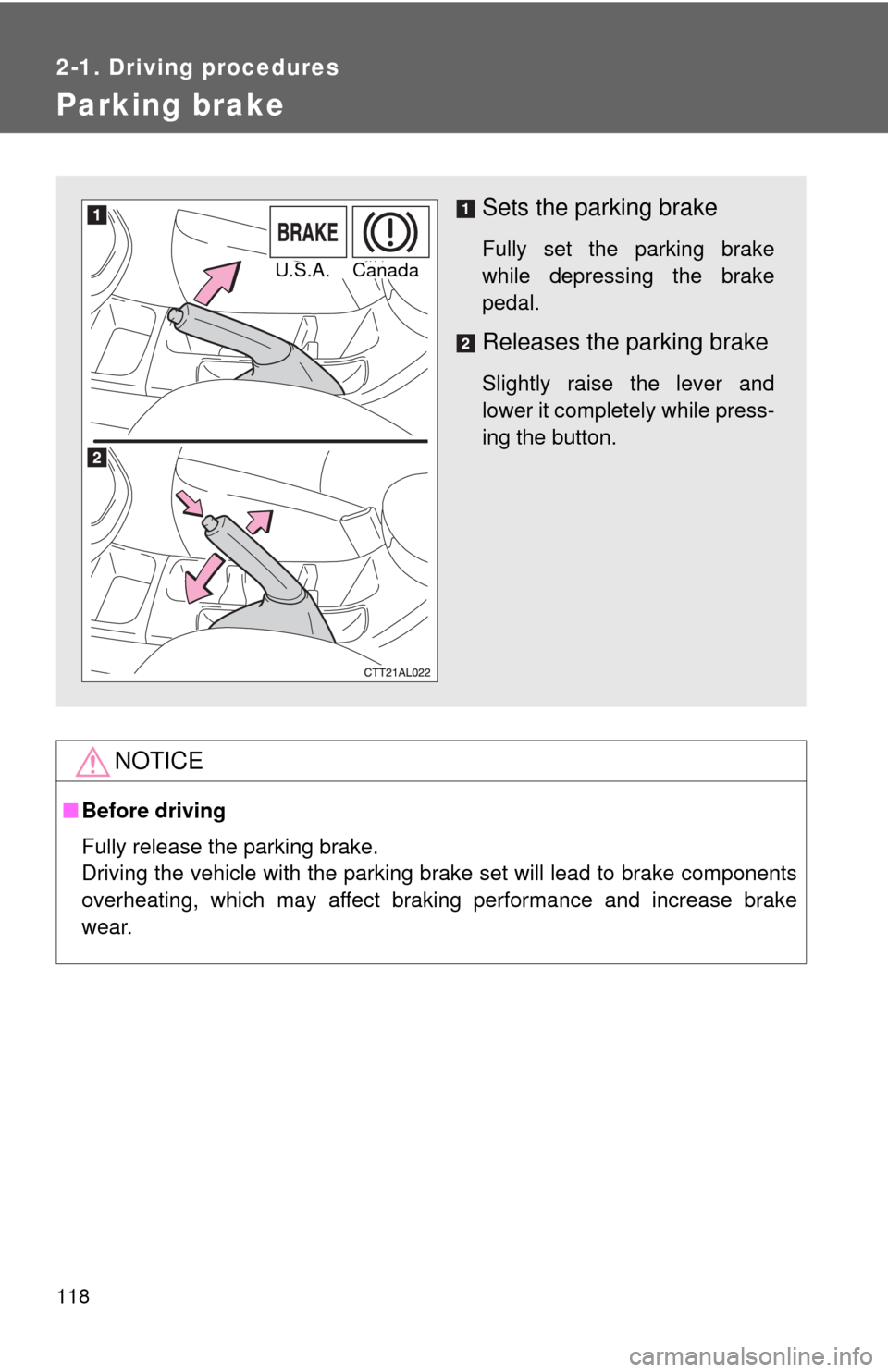
118
2-1. Driving procedures
Parking brake
NOTICE
■Before driving
Fully release the parking brake.
Driving the vehicle with the parking brake set will lead to brake components
overheating, which may affect braking performance and increase brake
wear.
Sets the parking brake
Fully set the parking brake
while depressing the brake
pedal.
Releases the parking brake
Slightly raise the lever and
lower it completely while press-
ing the button.
U.S.A. Canada
Page 121 of 440
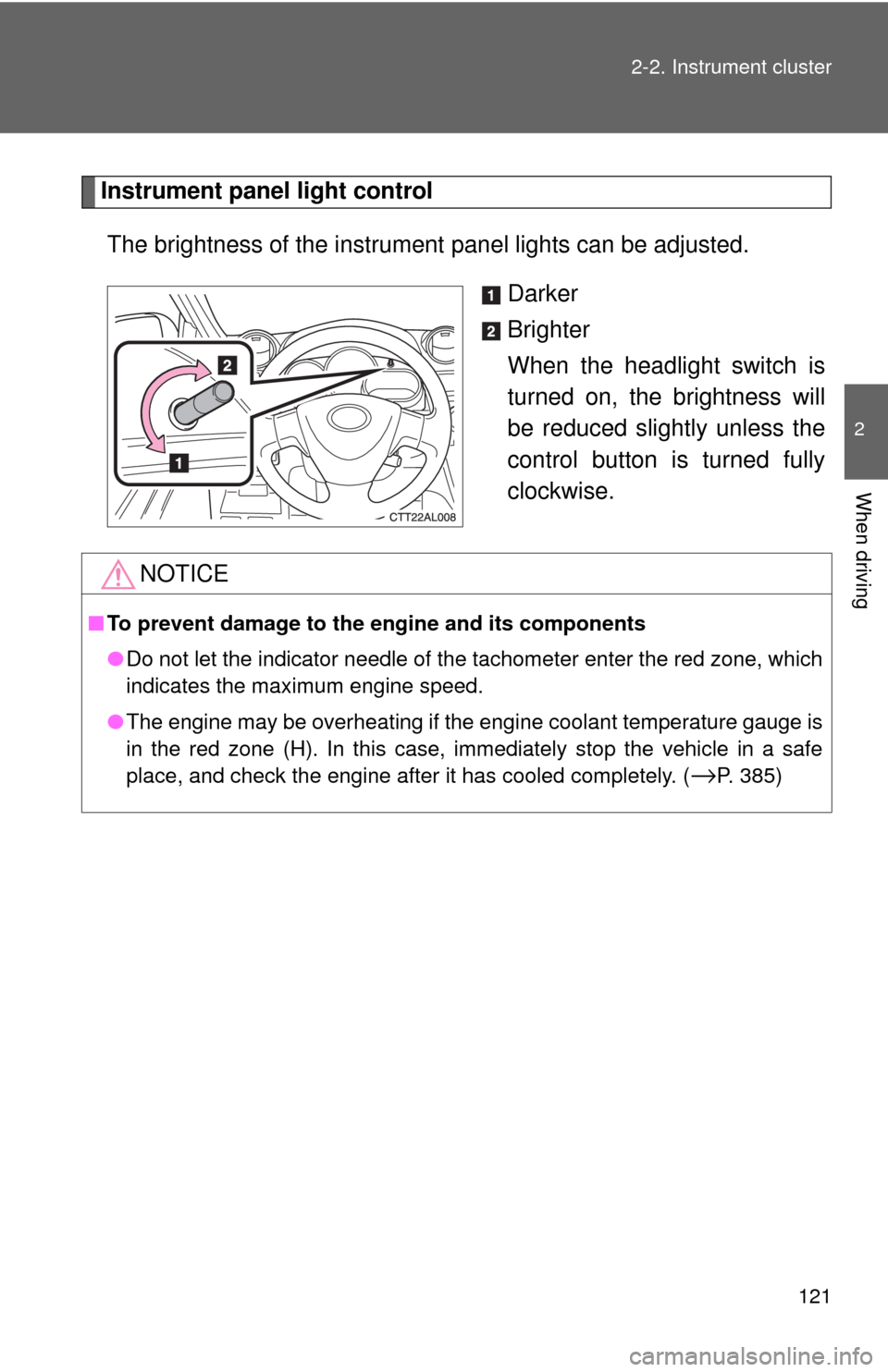
121 2-2. Instrument cluster
2
When driving
Instrument panel light control
The brightness of the instrument panel lights can be adjusted.
Darker
Brighter
When the headlight switch is
turned on, the brightness will
be reduced slightly unless the
control button is turned fully
clockwise.
NOTICE
■To prevent damage to the engine and its components
●Do not let the indicator needle of the tachometer enter the red zone, which
indicates the maximum engine speed.
●The engine may be overheating if the engine coolant temperature gauge is
in the red zone (H). In this case, immediately stop the vehicle in a safe
place, and check the engine after it has cooled completely. (
→P. 385)
Page 138 of 440
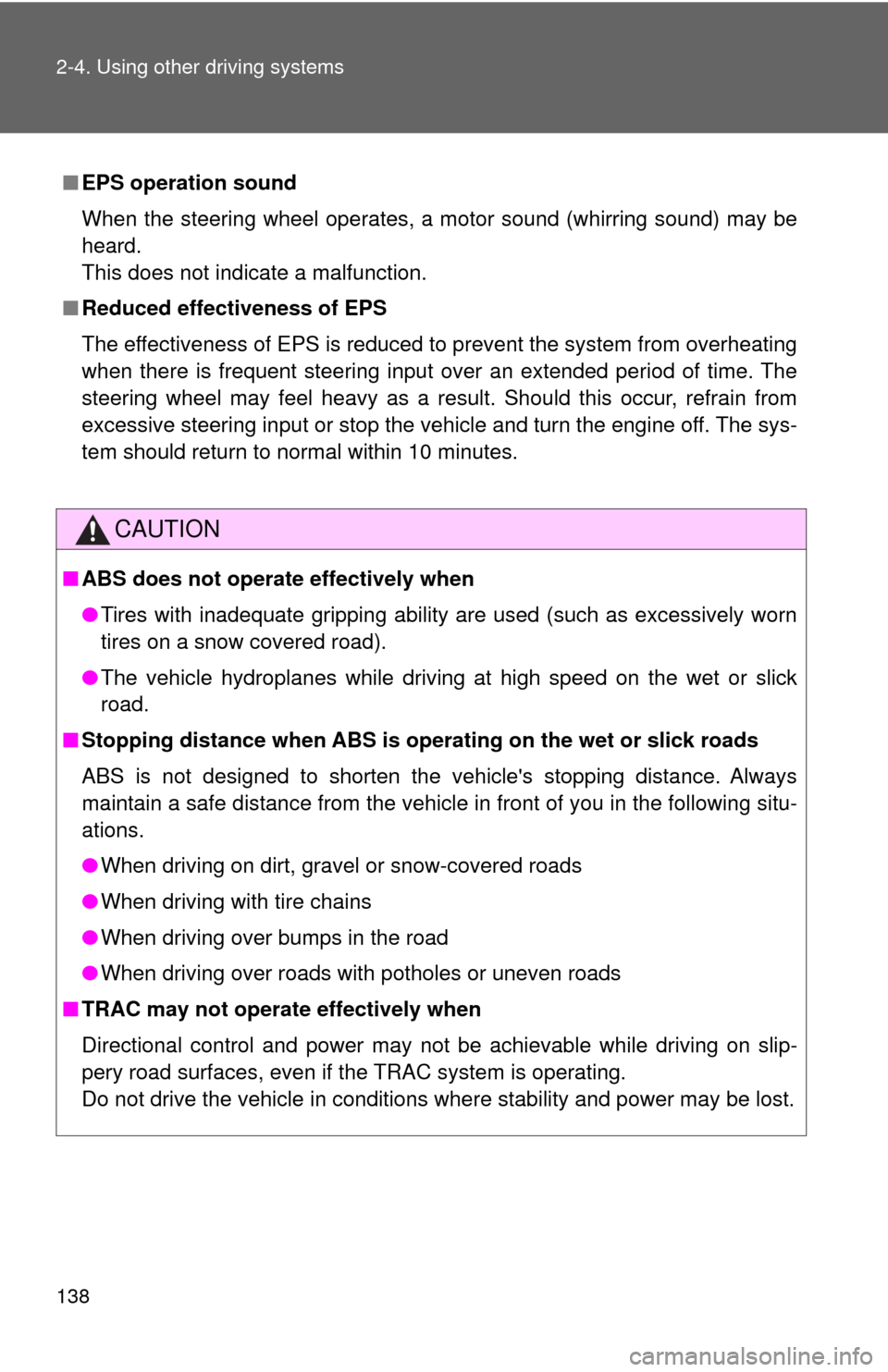
138 2-4. Using other driving systems
■EPS operation sound
When the steering wheel operates, a motor sound (whirring sound) may be
heard.
This does not indicate a malfunction.
■Reduced effectiveness of EPS
The effectiveness of EPS is reduced to prevent the system from overheating
when there is frequent steering input over an extended period of time. The
steering wheel may feel heavy as a result. Should this occur, refrain from
excessive steering input or stop the vehicle and turn the engine off. The sys-
tem should return to normal within 10 minutes.
CAUTION
■ABS does not operate effectively when
●Tires with inadequate gripping ability are used (such as excessively worn
tires on a snow covered road).
●The vehicle hydroplanes while driving at high speed on the wet or slick
road.
■Stopping distance when ABS is operating on the wet or slick roads
ABS is not designed to shorten the vehicle's stopping distance. Always
maintain a safe distance from the vehicle in front of you in the following situ-
ations.
●When driving on dirt, gravel or snow-covered roads
●When driving with tire chains
●When driving over bumps in the road
●When driving over roads with potholes or uneven roads
■TRAC may not operate effectively when
Directional control and power may not be achievable while driving on slip-
pery road surfaces, even if the TRAC system is operating.
Do not drive the vehicle in conditions where stability and power may be lost.
Page 154 of 440
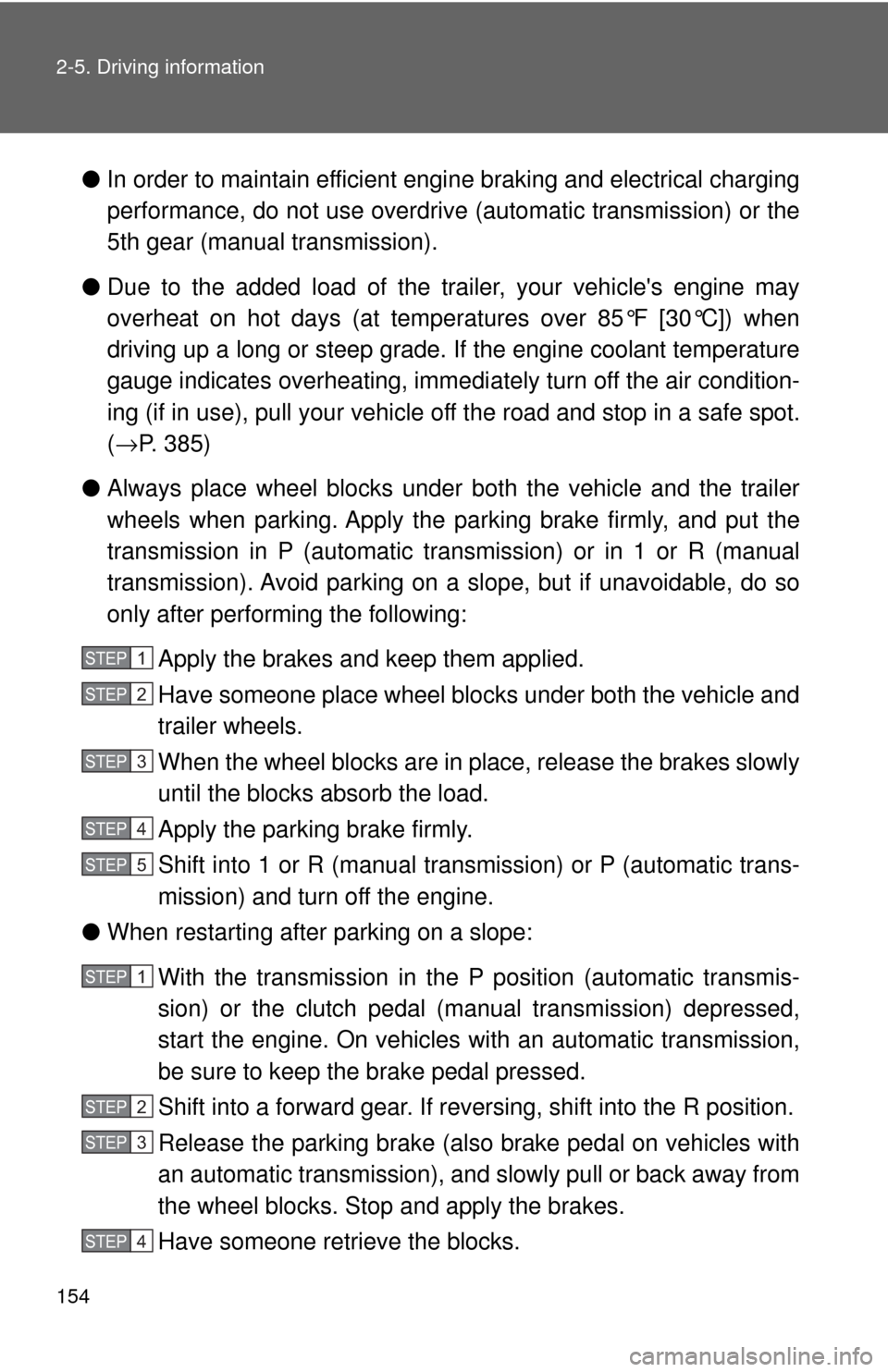
154 2-5. Driving information
●In order to maintain efficient engine braking and electrical charging
performance, do not use overdrive (automatic transmission) or the
5th gear (manual transmission).
●Due to the added load of the trailer, your vehicle's engine may
overheat on hot days (at temperatures over 85°F [30°C]) when
driving up a long or steep grade. If the engine coolant temperature
gauge indicates overheating, immediately turn off the air condition-
ing (if in use), pull your vehicle off the road and stop in a safe spot.
(→P. 385)
●Always place wheel blocks under both the vehicle and the trailer
wheels when parking. Apply the parking brake firmly, and put the
transmission in P (automatic transmission) or in 1 or R (manual
transmission). Avoid parking on a slope, but if unavoidable, do so
only after performing the following:
Apply the brakes and keep them applied.
Have someone place wheel blocks under both the vehicle and
trailer wheels.
When the wheel blocks are in place, release the brakes slowly
until the blocks absorb the load.
Apply the parking brake firmly.
Shift into 1 or R (manual transmission) or P (automatic trans-
mission) and turn off the engine.
●When restarting after parking on a slope:
With the transmission in the P position (automatic transmis-
sion) or the clutch pedal (manual transmission) depressed,
start the engine. On vehicles with an automatic transmission,
be sure to keep the brake pedal pressed.
Shift into a forward gear. If reversing, shift into the R position.
Release the parking brake (also brake pedal on vehicles with
an automatic transmission), and slowly pull or back away from
the wheel blocks. Stop and apply the brakes.
Have someone retrieve the blocks.
STEP1
STEP2
STEP3
STEP4
STEP5
STEP1
STEP2
STEP3
STEP4
Page 386 of 440
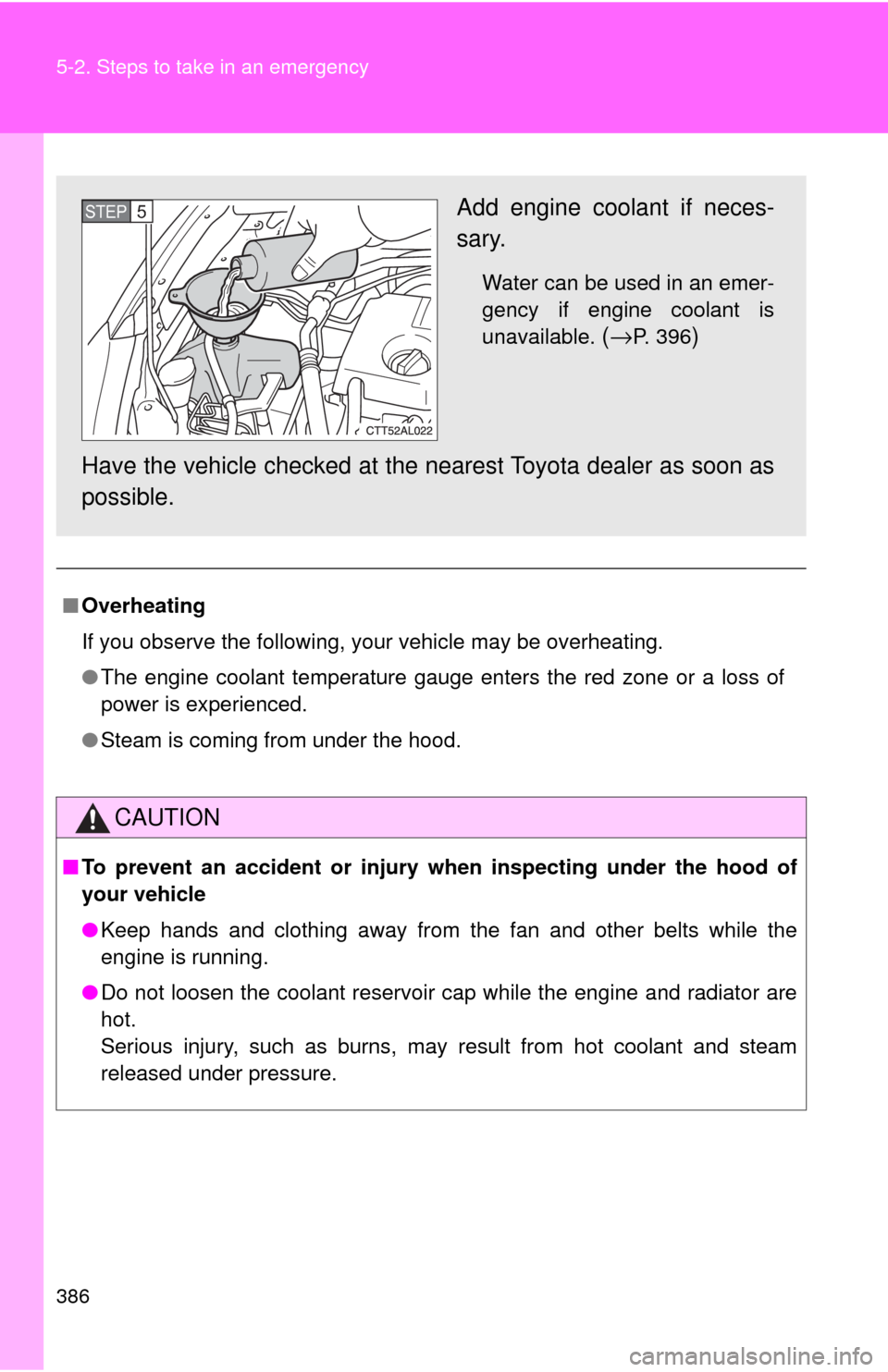
386 5-2. Steps to take in an emergency
■Overheating
If you observe the following, your vehicle may be overheating.
●The engine coolant temperature gauge enters the red zone or a loss of
power is experienced.
●Steam is coming from under the hood.
CAUTION
■To prevent an accident or injury when inspecting under the hood of
your vehicle
●Keep hands and clothing away from the fan and other belts while the
engine is running.
●Do not loosen the coolant reservoir cap while the engine and radiator are
hot.
Serious injury, such as burns, may result from hot coolant and steam
released under pressure.
Add engine coolant if neces-
sary.
Water can be used in an emer-
gency if engine coolant is
unavailable.
(→P. 396)
Have the vehicle checked at the nearest Toyota dealer as soon as
possible.
STEP5
Page 430 of 440

430 Alphabetical index
Care
Exterior .................................. 268
Interior ................................... 270
Seat belts .............................. 271
Cargo capacity ......................... 140
Cargo hooks ............................. 255
CD changer ............................... 178
CD player .................................. 178
Chains ....................................... 144
Child restraint system
Booster seats, definition ..........82
Booster seats, installation .......86
Convertible seats,
definition ...............................82
Convertible seats,
installation .............................86
Front passenger occupant
classification system .............77
Infant seats, definition .............82
Infant seats, installation...........86
Installing CRS with lower
anchorages ...........................90
Installing CRS with
seat belts ..............................87
Installing CRS with top
straps ....................................92Child safety
Airbag precautions .................. 72
Battery precautions ....... 300, 383
Child restraint system ............. 82
Child-protectors....................... 30
How your child should wear
the seat belt .......................... 43
Installing child restraints.......... 86
Moon roof precautions ............ 55
Power window lock switch ...... 51
Power window precautions ..... 52
Removed key battery
precautions ......................... 321
Seat belt extender
precautions ........................... 45
Seat belt precautions .............. 44
Child-protectors ......................... 30
Cleaning
Exterior.................................. 268
Interior ................................... 270
Seat belts .............................. 271
Clock ......................................... 246
Compass................................... 262
Condenser ................................ 296
Console box ............................. 237
Cooling system
Engine overheating ............... 385
Cruise control .......................... 132
Cup holder ................................ 239
Curtain shield airbags ............... 65
Customizable features ............ 420C
Page 431 of 440

431 Alphabetical index
Daytime running light
system ................................... 126
Defogger
Rear window......................... 168
Side mirror ............................ 168
Dimension ................................ 390
Dinghy towing .................. 156,157
Display
Trip meter ............................. 119
Do-it-yourself maintenance .... 279
Doors
Door glasses .......................... 51
Door lock .......................... 26, 29
Side mirrors ............................ 49
Driver's seat belt reminder
light ........................................ 355
Driving
Break-in tips ........................... 98
Correct posture....................... 63
Procedures ............................. 96
Winter driving tips ................. 144
Electric power steering........... 135
Emergency, in case of
If a warning light turns on ..... 352
If the engine will not start...... 376
If the shift lever cannot be
shifted from P ..................... 377
If the vehicle has a
discharged battery ............. 379
If the warning buzzer
sounds ............................... 352If you have a flat tire .............362
If you lose your keys .............378
If you think something is
wrong ..................................348
If your vehicle becomes
stuck ...................................388
If your vehicle needs to be
towed ..................................342
If your vehicle overheats .......385
Engine
Compartment ........................288
Engine switch ........................106
Hood......................................283
How to start the
engine .................................106
Identification number .............391
If the engine will not start ......376
Ignition switch........................106
Overheating...........................385
Engine coolant
Capacity ................................396
Checking ...............................295
Preparing and checking before
winter ..................................144
Engine coolant temperature
gauge ......................................119
Engine immobilizer system.......60
Engine oil
Capacity ................................395
Checking ...............................290
Preparing and checking before
winter ..................................144
Engine oil maintenance
data .........................................293
EPS ............................................135
Event data recorder .................350D
E
Page 434 of 440

434 Alphabetical index
Odometer .................................. 119
Oil
Engine oil .............................. 290
Opener
Fuel filler door .........................56
Hood...................................... 283
Outside rear view mirrors
Adjusting and folding ...............49
Outside temperature
display .................................... 119
Overheating, Engine ................385
Parking brake ........................... 118
Parking lights
Replacing light bulb ............... 332
Switch.................................... 125
Wattage ................................. 404
Personal lights
Switch............................ 234, 235
Wattage ................................. 404
Power outlet ............................. 249
Power windows ..........................51Radiator .................................... 296
Radio ......................................... 172
Rear side marker lights
Replacing light bulb............... 332
Switch ................................... 125
Wattage................................. 404
Rear seats
Folding down........................... 38
Rear turn signal lights
Replacing light bulbs ............. 332
Switch ................................... 117
Wattage................................. 404
Rear view mirror
Compass ............................... 262
Rear window defogger ............ 168
Rear window wiper .................. 131
Replacing
Fuses .................................... 323
Key battery ............................ 320
Light bulbs............................. 332
Tires ...................................... 362
Reporting safety defects for
U.S.A. owners ........................ 424O
P
R